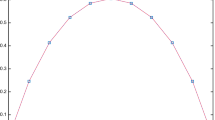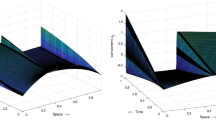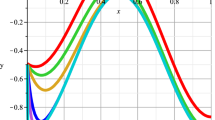Abstract
This paper focuses on some mathematical and numerical aspects of reaction-diffusion problems pertaining to non-integer time derivatives using the well-known method of lower and upper solutions combined with the monotone iterative technique. First, we study the existence and uniqueness of weak solutions of the proposed models, then we prove some comparison results. Besides, linear finite element spaces on triangles are used to discretize the problem in space, whereas the generalized backward-Euler method is adopted to approximate the time non-integer derivative. Furthermore, the idea of this method is to construct two sequences of solutions of a linear initial value problem which are easier to compute and converge to the solution of the nonlinear problem. We show numerically through two examples that this convergence requires only few iterations. Some well-known examples with exact solutions and numerical results based on the finite element method in 2D are provided to validate the theoretical results. As a result, we confirm that the proposed method is efficient and easy to use to overcome the convergence and stability difficulties.
















Similar content being viewed by others
References
Adolfsson K, Enelund M, Olsson P (2005) On the fractional order model of viscoelasticity. Mech Time-dependent Mater 9(1):15–34
Kumar D, Baleanu D (2019) Fractional calculus and its applications in physics. Front Phys 7:81
Hilfer R (2000) Applications of fractional calculus in physics. World Scientific
Tarasov VE (2013) Review of some promising fractional physical models. Int J Mod Phys B 27(09):1330005
Zhou H, Yang S, Zhang S (2018) Conformable derivative approach to anomalous diffusion. Physica A 491:1001–1013
Tuan NH, Ngoc TB, Baleanu D, O’Regan D (2020) On well-posedness of the sub-diffusion equation with conformable derivative model. Commun Nonlinear Sci Numer Simul 89:105332
Drapaca C, Sivaloganathan S (2012) A fractional model of continuum mechanics. J Elast 107(2):105–123
Atanacković TM, Pilipović S, Stanković B, Zorica D (2014) Fractional calculus with applications in mechanics. Wiley Online Library, Hoboken
Kilbas AA, Srivastava HM, Trujillo JJ (2006) Theory and applications of fractional differential equations, vol 204. Elsevier, Amsterdam
Podlubny I (1998) Fractional differential equations: an introduction to fractional derivatives, fractional differential equations, to methods of their solution and some of their applications. Elsevier, Amsterdam
Miller KS, Ross B (1993) An introduction to the fractional calculus and fractional differential equations. Wiley
Zhou Y, Wang J, Zhang L (2016) Basic theory of fractional differential equations. World scientific
Ma X, Wu W, Zeng B, Wang Y, Wu X (2020) The conformable fractional grey system model. ISA Trans 96:255–271
Boccaletti S, Ditto W, Mindlin G, Atangana A (2020) Modeling and forecasting of epidemic spreading: the case of COVID-19 and beyond. Chaos Solitons Fract 135:109794
Singh J, Kumar D, Hammouch Z, Atangana A (2018) A fractional epidemiological model for computer viruses pertaining to a new fractional derivative. Appl Math Comput 316:504–515
Almeida R, da Cruz AMB, Martins N, Monteiro MTT (2019) An epidemiological MSEIR model described by the Caputo fractional derivative. Int J Dyn Control 7(2):776–784
Royston P, Ambler G, Sauerbrei W (1999) The use of fractional polynomials to model continuous risk variables in epidemiology. Int J Epidemiol 28(5):964–974
Goufo EFD, Maritz R, Munganga J (2014) Some properties of the Kermack-McKendrick epidemic model with fractional derivative and nonlinear incidence. Adv Differ Equ 2014(1):1–9
Alla Hamou A, Azroul E, Hammouch Z, Alaoui AL (2021) A Fractional Multi-Order Model to Predict the COVID-19 Outbreak in Morocco. Appl Comput Math 20(1):177–203
Meerschaert MM, Sikorskii A (2011) Stochastic models for fractional calculus, vol 43. Walter de Gruyter
Çenesiz Y, Kurt A, Nane E (2017) Stochastic solutions of conformable fractional Cauchy problems. Stat Probab Lett 124:126–131
Yang Q, Chen D, Zhao T, Chen Y (2016) Fractional calculus in image processing: a review. Fract Calc Appl Anal 19(5):1222–1249
Larnier S, Mecca R (2012) Fractional-order diffusion for image reconstruction, In: 2012 IEEE International Conference on Acoustics, Speech and Signal Processing (ICASSP), IEEE, 1057–1060
Bai J, Feng X-C (2007) Fractional-order anisotropic diffusion for image denoising. IEEE Trans Image Process 16(10):2492–2502
Cruz-Duarte JM, Rosales-Garcia J, Correa-Cely CR, Garcia-Perez A, Avina-Cervantes JG (2018) A closed form expression for the Gaussian-based Caputo-Fabrizio fractional derivative for signal processing applications. Commun Nonlinear Sci Numer Simul 61:138–148
Epstein CL (2007) Introduction to the mathematics of medical imaging. SIAM
Deng W, Li C (2005) Chaos synchronization of the fractional Lü system. Physica A 353:61–72
Hartley TT, Lorenzo CF, Qammer HK (1995) Chaos in a fractional order Chua’s system. IEEE Trans Circ Syst I 42(8):485–490
Li C, Chen G (2004) Chaos in the fractional order Chen system and its control. Chaos Solitons Fract 22(3):549–554
Owolabi KM, Karaagac B (2020) Chaotic and spatiotemporal oscillations in fractional reaction-diffusion system. Chaos Solitons Fract 141:110302. ISSN 0960–0779. https://doi.org/10.1016/j.chaos.2020.110302, https://www.sciencedirect.com/science/article/pii/S0960077920306986
Sweilam NH, El-Sayed AAE, Boulaaras S (2021) Fractional-order advection-dispersion problem solution via the spectral collocation method and the non-standard finite difference technique. Chaos Solitons Fract 144:110736
Kumar S, Pandey P (2020) A Legendre spectral finite difference method for the solution of non-linear space-time fractional Burger’s-Huxley and reaction-diffusion equation with Atangana-Baleanu derivative. Chaos Solitons Fract 130:109402
Hu Y, Li C, Li H (2017) The finite difference method for Caputo-type parabolic equation with fractional Laplacian: one-dimension case. Chaos Solitons Fract 102:319–326
Jin B, Lazarov R, Zhou Z (2013) Error estimates for a semidiscrete finite element method for fractional order parabolic equations. SIAM J Numer Anal 51(1):445–466
Zhao X, Hu X, Cai W, Karniadakis GE (2017) Adaptive finite element method for fractional differential equations using hierarchical matrices. Comput Methods Appl Mech Eng 325:56–76
Deng W (2009) Finite element method for the space and time fractional Fokker-Planck equation. SIAM J Numer Anal 47(1):204–226
Jin B, Lazarov R, Zhou Z (2016) A Petrov-Galerkin finite element method for fractional convection-diffusion equations. SIAM J Numer Anal 54(1):481–503
Zheng Y, Zhao Z (2020) The time discontinuous space-time finite element method for fractional diffusion-wave equation. Appl Numer Math 150:105–116
Deng W (2009) Finite element method for the space and time fractional Fokker-Planck equation. SIAM J Numer Anal 47(1):204–226. https://doi.org/10.1137/080714130
Kumar D, Chaudhary S, Kumar VS (2019) Finite element analysis for coupled time-fractional nonlinear diffusion system. Comput Math Appl 78(6):1919–1936
Gao F, Wang X (2014) A modified weak Galerkin finite element method for a class of parabolic problems. J Comput Appl Math 271:1–19
Zheng Y, Zhao Z (2017) The discontinuous Galerkin finite element method for fractional cable equation. Appl Numer Math 115:32–41. ISSN 0168-9274, https://doi.org/10.1016/j.apnum.2016.12.006, https://www.sciencedirect.com/science/article/pii/S0168927417300053
Jin B, Lazarov R, Zhou Z (2013) Error estimates for a semidiscrete finite element method for fractional order parabolic equations. SIAM J Numer Anal 51(1):445–466. https://doi.org/10.1137/120873984
Xu T, Liu F, Lü S, Anh VV (2020) Finite difference/finite element method for two-dimensional time-space fractional Bloch-Torrey equations with variable coefficients on irregular convex domains. Comput Math Appl 80(12):3173–3192
Liu X, Yang X (2021) Mixed finite element method for the nonlinear time-fractional stochastic fourth-order reaction-diffusion equation. Comput Math Appl 84:39–55
Jia J, Wang H, Zheng X (2021) A preconditioned fast finite element approximation to variable-order time-fractional diffusion equations in multiple space dimensions. Appl Numer Math 163:15–29
Li D, Liao H-L, Sun W, Wang J, Zhang J, Analysis of \(L1\)-Galerkin FEMs for time-fractional nonlinear parabolic problems, arXiv preprint arXiv:1612.00562
Pao C (1993) Positive solutions and dynamics of a finite difference reaction-diffusion system. Num Methods Part Differ Equ 9(3):285–311
Pao C (1996) Blowing-up and asymptotic behaviour of solutions for a finite difference system. Appl Anal 62(1–2):29–38
Bellman R, Juncosa ML, Kalaba R (1961) Some numerical experiments using newton’s method for nonlinear parabolic and elliptic boundary-value problems. Commun ACM 4(4):187–191, ISSN 0001-0782, https://doi.org/10.1145/355578.366508
Parter SV (1964) Mildly nonlinear elliptic partial differential equations and their numerical solution. I, Tech. Rep., Wisconsin Univ Madison Mathematics Research Center R
Greenspan D, Parter SV (1964) Mildly nonlinear elliptic partial differential equations and their numerical solution. Tech. Rep., Wisconsin Univ Madison Mathematics Research Center, II
Walter W (1968) Die Linienmethode bei nichtlinearen parabolischen Differentialgleichungen. Numer Math 12(4):307–321
Pao C (2002) Finite difference reaction-diffusion systems with coupled boundary conditions and time delays. J Math Anal Appl 272(2):407–434
Pao C (2001) Numerical solutions of reaction-diffusion equations with nonlocal boundary conditions. J Comput Appl Math 136(1–2):227–243
Pao C-V (2012) Nonlinear parabolic and elliptic equations. Springer Science & Business Media
Pao C-V (1982) On nonlinear reaction-diffusion systems. J Math Anal Appl 87(1):165–198
Pao C (1985) Monotone iterative methods for finite difference system of reaction-diffusion equations. Numer Math 46(4):571–586
Khalil R, Al Horani M, Yousef A, Sababheh M (2014) A new definition of fractional derivative. J Comput Appl Math 264:65–70. https://doi.org/10.1016/j.cam.2014.01.002
Abdeljawad T (2015) On conformable fractional calculus. J Comput Appl Math 279:57–66. https://doi.org/10.1016/j.cam.2014.10.016
Wang Y, Zhou J, Li Y (2016) Fractional Sobolev’s spaces on time scales via conformable fractional calculus and their application to a fractional differential equation on time scales. Adv Math Phys 2016:1–22. https://doi.org/10.1155/2016/9636491
Benkhettou N, Hassani S, Torres DF (2016) A conformable fractional calculus on arbitrary time scales. J King Saud Univ-Sci 28(1):93–98. https://doi.org/10.1016/j.jksus.2015.05.003
Abdeljawad T (2015) On conformable fractional calculus. J Comput Appl Math 279:57–66
Alla Hamou A, Azroul E, Alaoui A (2020) Monotone iterative technique for nonlinear periodic time fractional parabolic problems. Adv Theory Nonlinear Anal Appl 4(3):194–213
Brezis H, Ciarlet PG, Lions JL (1999) Analyse fonctionnelle: théorie et applications, vol 91. Dunod Paris
Adams RA, Fournier JJ (2003) Sobolev spaces. Elsevier
Alla hamou A, Azroul E, Hammouch Z, Lamrani alaoui A, Modeling and numerical investigation of a Conformable co-infection model for describing Hantavirus of the European moles, math. meth. app. sci. Preprint
Author information
Authors and Affiliations
Corresponding author
Additional information
Publisher's Note
Springer Nature remains neutral with regard to jurisdictional claims in published maps and institutional affiliations.
Rights and permissions
About this article
Cite this article
Hamou, A.A., Azroul, E., Hammouch, Z. et al. A monotone iterative technique combined to finite element method for solving reaction-diffusion problems pertaining to non-integer derivative. Engineering with Computers 39, 2515–2541 (2023). https://doi.org/10.1007/s00366-022-01635-4
Published:
Issue Date:
DOI: https://doi.org/10.1007/s00366-022-01635-4
Keywords
- Reaction-diffusion problems
- Non-integer derivative
- Upper and lower solutions
- Monotone iterative technique
- Finite element method




